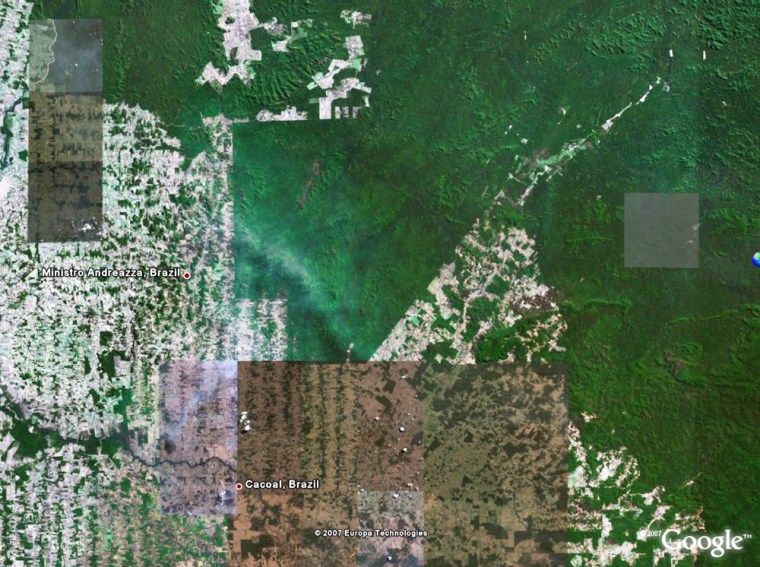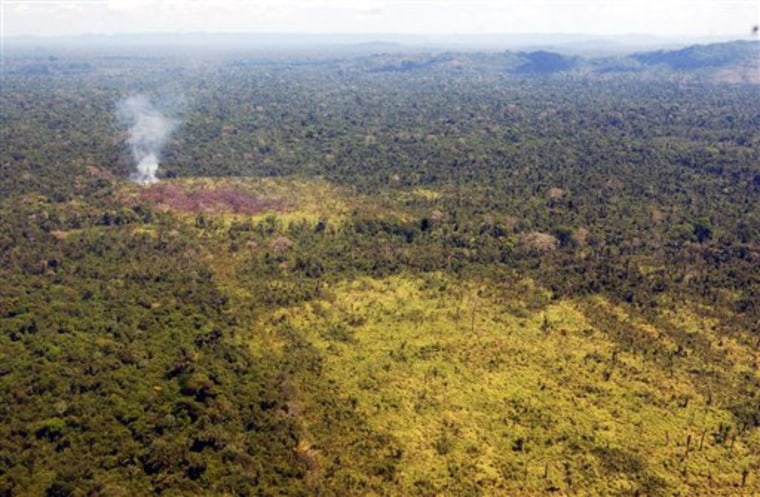Brazil will combat rising deforestation in the Amazon by sending extra federal police and environmental protection officers to areas where illegal clearing of the rain forest jumped dramatically last year, officials said Thursday.
Authorities will also monitor the areas where the deforestation occurred in an attempt to prevent anyone from trying to plant crops or raise cattle there, said Environment Minister Marina Silva.
The measures were announced after President Luiz Inacio Lula da Silva called an emergency meeting of Cabinet ministers to discuss new data showing an apparent reverse of a three-year decline that Silva has repeatedly praised.
The clearing of Brazil's Amazon rain forest jumped in the final months of 2007, spurred by heavy market demand for corn, soy and cattle. The 36 areas being targeted registered the highest rates of deforestation, environmental officials said.
Officials will also try to fine people or businesses who buy anything produced on the deforested land in the 36 small cities and towns, the environment minister said.
The plan means a 25 percent increase in the police force assigned to the region, though Justice Minister Tarso Genro did not say how many officers will take part.
Farmers working deforested land in the targeted area will also be forced to reregister holdings with government officials to prove their holdings were not illegally cleared, and there will be no new permits for logging.
'Working with the worst hypothesis'
If the plan doesn't work, Minister Silva said Brazil "will have an environmental loss and an economic loss."
Silva's ministry estimates as much as 2,700 square miles of rain forest was cleared from August through December, meaning that Brazil could lose 5,800 square miles of jungle by August if the rate continues.
That would represent a sharp increase from the 4,300 square miles that was cut down and burned from August 2006 through July of last year.
Although preliminary calculations can only prove that 1,287 square miles of rain forest were cleared from August through December, ministry official Joao Paulo Capobianco said experts are still analyzing satellite imagery and working under the assumption that the higher amount of jungle was cleared.
"We're working with the worst hypothesis," he said, according to Brazil's official Agencia Brasil news service.
The Environment Ministry could not immediately provide data to precisely compare the five-month destruction rate for last year to the same period in 2006.
Concentration in 3 states
Most of last year's destruction happened in November and December and was concentrated in the three Amazon region states of Mato Grosso, Para and Rondonia.

Mato Grosso is the center of Brazil's important soy production industry, and Latin America's largest nation is second only to the United States for production.
Jungle is typically cleared in the Amazon to provide pasture for cattle, then soy farmers move in later and cultivate their crops. Brazil also has a booming beef export industry, and cattle ranchers have been expanding their operations in the Amazon.
Brazil last year trumpeted a drop in Amazon deforestation, but the new numbers appeared to indicate that the situation has been reversed.
Paulo Adario, coordinator of Greenpeace's Amazon campaign, said it's important for the government to act now because slash-and-burn deforestation typically ramps up this time of year at the start of the rainy season.
